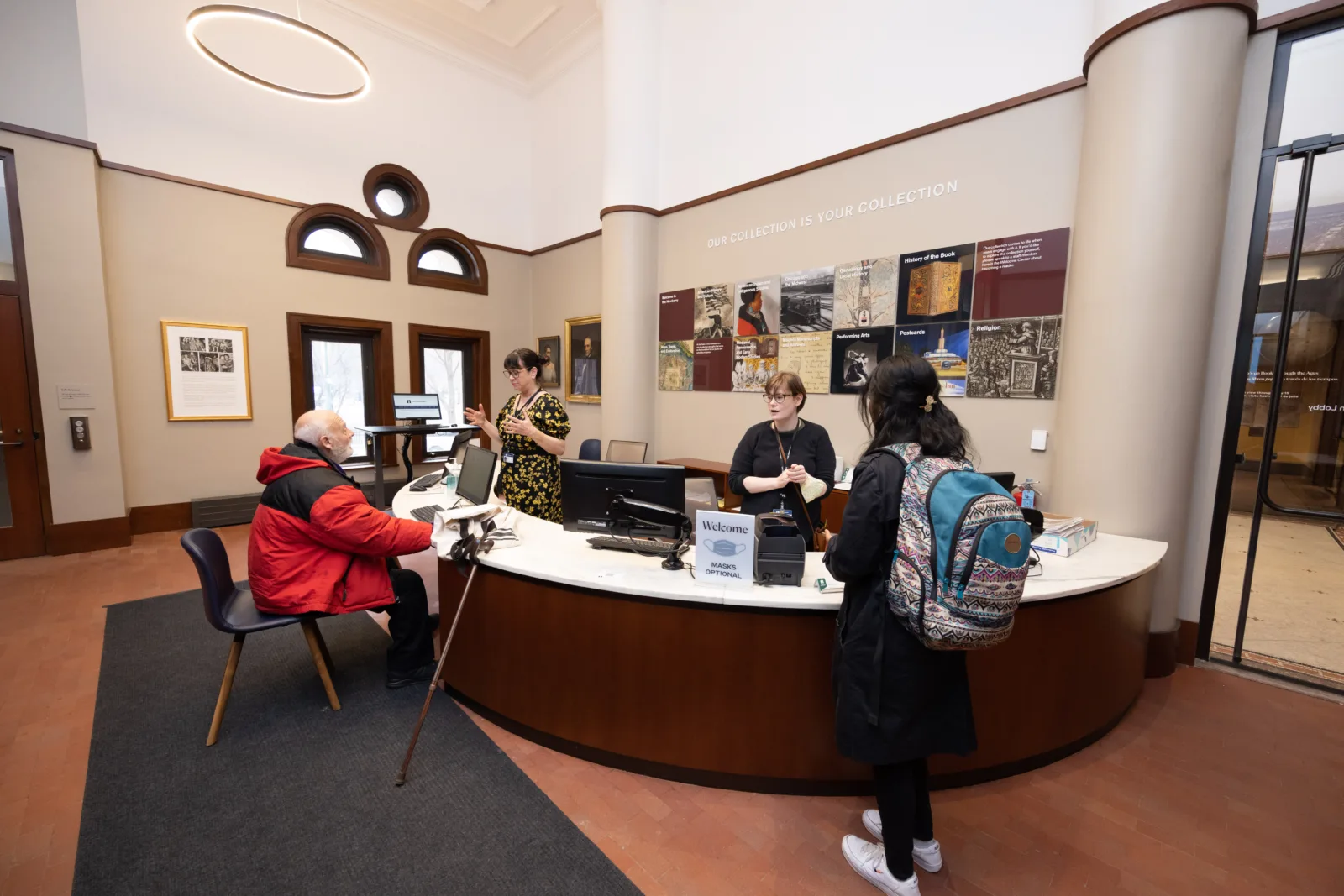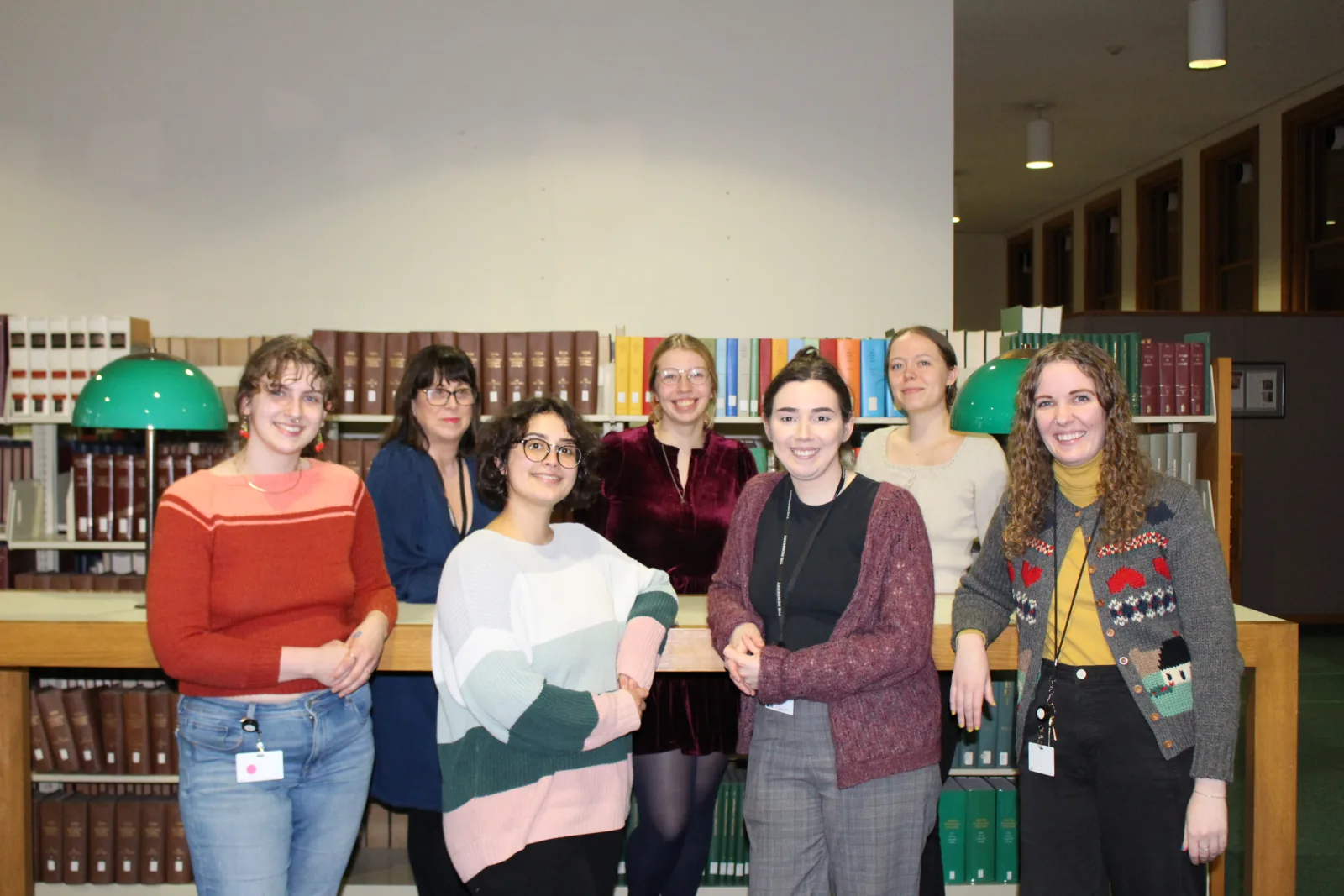Since the founding of the Newberry in 1887, its raison d’être has been connecting the public with the riches of its collection. When the library first opened, readers had access to collection materials through open shelving in the Reading Rooms. As the library evolved and its collection grew, open shelving put a strain on the Newberry staff and jeopardized the security of the collection. Eventually, we converted to the centralized storage system we have today, but our Reading Rooms remain core to our mission and operations.
All aspects of the Newberry’s two Reading Rooms are managed by our industrious and hard-working Reader Services staff. In celebration of National Library Week, we invite you to learn more about these critical members of the Newberry team. Anyone with a research interest, whether an impromptu breeze through the Reading Rooms on a Friday afternoon or a dedicated researcher immersed in a years-long project, works closely with our Reader Services staff. They are among the library’s most public-facing staff and are dedicated to increasing the collection’s accessibility, connecting curious visitors with the answers to their questions, and accurately representing the collection’s almost boundless stores of knowledge and information.
Readers might be most familiar with the faces of the Newberry’s eight Library Assistants, who bring requested materials to the Reading Rooms. “The Library Assistants are the bread and butter of Reader Services, and in a way, of the Newberry itself,” says Keva Kreeger, Reading Room Librarian for Public Service. “Assistants help with paging items, searching in the stacks building, making deliveries of items all over the library, and serving as touchpoints for the public in the second- and fourth-floor Reading Rooms.” “Many, many Newberry employees started as Library Assistants and worked their way up into new positions,” adds Emma Lipkin, Reading Room Librarian for Collection Management.
“One of the things we pride ourselves on is that we aim to deliver things fast to folks,” says Kreeger. In many other libraries, there are quotas in place, with researchers only being able to look at a few items per day. At the Newberry there’s no limit to the number of items we’ll page for you over the course of your visit.
Lipkin adds, “The only things that a reader would not be able to access are items which are currently being repaired or looked after by our Conservation staff.” There are also some limits on how long certain objects may be exposed to light at a time, but that applies to very few objects, and the restrictions are not severe. “Other than that, the access afforded to anybody with a Readers card is really quite remarkable.”
While Library Assistants connect visitors to the items they want to see in the Reading Rooms, librarians in the department answer more in-depth inquiries from readers about the collection and help to guide their research, whether in-person in the Newberry’s Welcome Center or Reading Rooms, or via phone or email.

If you’ve ever sent an email to the “Ask a Librarian” contact email, Jo Ellen McKillop Dickie, Reference Services Librarian, was likely the one to route your inquiry to the appropriate staff member, as she is responsible for managing the main reference requests. “Inquiries are as diverse as our readers,” says Dickie. Lots of questions tend to be collection-specific, but others are more general or people simply looking for guidance. “We get frequent requests about the Pullman Company archives, which are typically by people who are doing genealogy looking for employee records or those who are restoring old Pullman cars and need more details. You truly never know what people might come in and ask about, which makes every day full of exciting possibilities. With our new exhibition on Mister Kelly’s, someone recently wanted to know what sauce was used on the lobster tail at the club!” For more complex research questions, the Reader Services staff works as a team to connect readers with the appropriate collections expert, whether in genealogy, Indigenous Studies, or any other topic represented in our collection.
Matthew Rutherford, Curator of Genealogy and Local History, has seen public interest in genealogy and family history take off in his nineteen years with the Newberry. While there are fewer researchers coming to the Newberry as absolute beginners than there used to be, many are still impressed and perhaps overwhelmed at the scope of what the Newberry has to offer them. “I think the Newberry's collections stand out,” says Rutherford, “not only because of their own breadth and depth (e.g., over 65,000 published family histories, over 55,000 city directories, and so on) but because of the way they work in conjunction with other collection strengths.” As the largest single segment of daily readers, comprising 30-35% of all visitors to the Newberry, genealogists know how exceptional the Newberry’s collections are; the library’s wide range of historical resources allows researchers to contextualize their ancestors’ lives.
At its core, the department’s goal is to create a welcoming environment for anyone to enjoy. “Our job really is to build relationships with people,” says Kreeger, “not just the public coming in to do research, but with everyone else at the Newberry, including our fellows and folks doing longer-term research.” Customer service is also always top of mind: “We deliver a white glove service unlike anywhere else. One of the joys of the job is being invested in the inquiries and building long-lasting relationships with our patrons who frequently stop by.”
When compared to many of its peer institutions, the Newberry’s openness and accessibility is remarkable – thanks to Walter Newberry’s vision for a “free library for the people of Chicago.” Our Reader Services Department ensures that Walter’s idea remains a reality for the thousands of readers who make use of our collections each year.
